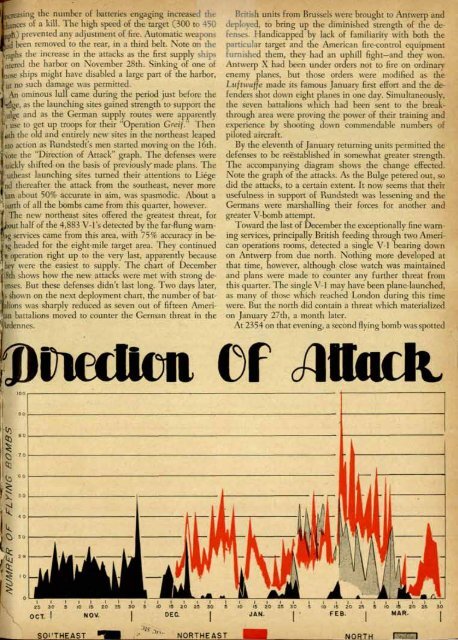September-October - Air Defense Artillery
September-October - Air Defense Artillery
September-October - Air Defense Artillery
Create successful ePaper yourself
Turn your PDF publications into a flip-book with our unique Google optimized e-Paper software.
easing the number of batteries engaging increased the<br />
gnees of a kill. The high speed of the target (300 to 450<br />
ph) prevented any adjustment of fire. Automatic weapons<br />
d been removed to the rear, in a third belt. Note on the<br />
r3phs the increase in the attacks as the first supply ships<br />
Olered the harbor on November 28th. Sinking of one of<br />
nose ships might' have disabled a large part of the harbor,<br />
j ul no such damage was permitted.<br />
An ominous lull came during the period just before the<br />
ge, as the launching sites gained strength to support the<br />
ulge and as the German supply routes were apparently<br />
1 use to get up troops for their "Operation Greif." Then<br />
~lh the old and entirely new sites in the northeast leaped<br />
oto action as Rundstedt's men started moving on the 16th.<br />
~ote the "Direction of Attack" graph. The defenses were<br />
uickly shifted on the basis of previously- made plans. The<br />
-utheast launching sites turned their attentions to Liege<br />
nd thereafter the attack from the southeast, never more<br />
han about 50% accurate in aim, was spasmodic. About a<br />
~ourthof all the bombs came from this quarter, however.<br />
The new nort.hea st sites offered the greatest threat, for<br />
ut half of the 4,883 V-l's detected by the far-Hung warn-<br />
~gservices came from this area, with 75% accuracy in be-<br />
lilg headed for the eight-mile target area. They continued<br />
l1 operation right up to the very last, apparently because<br />
q hey were the easiest to supply. The chart of December<br />
18thshows how the new attacks were met with strong deenses.<br />
But these defenses didn't last long. Two days later,<br />
IS shown on the next deployment chart, the number of batlions<br />
was sharply reduced as seven out of fifteen Amerin<br />
battalions moved to counter the German threat in the<br />
rdennes.<br />
V)<br />
80<br />
ctJ<br />
~<br />
~ 70<br />
~<br />
~ 60<br />
~ 50<br />
).....<br />
-...J<br />
~40<br />
~30<br />
~ 2e<br />
~ 10<br />
~0<br />
"-<br />
1 1<br />
25 30<br />
OCT. I NOV.<br />
SOI'THEAST -<br />
J1S<br />
-<br />
.)rl~<br />
British units from Brussels were brought to Antwerp and<br />
deployed, to bring up the diminished strength of the defenses.<br />
Handicapped by lack of familiarity with both the<br />
particular target and the American fire-control equipment<br />
furnished them, they had an uphill fight-and they won.<br />
Antwerp X had been under orders not to fire on ordinary<br />
enemy planes, but those orders were modified as the<br />
Luftwaffe made its famous January first effort and the defenders<br />
shot down eight planes in one day. Simultaneously,<br />
the seven battalions which had been sent to the break-<br />
through area were proving the power of their training and<br />
experience by shooting down commendable numbers of<br />
piloted aircraft.<br />
By the eleventh of January returning units permitted the<br />
defenses to be reestablished in somewhat greater strength.<br />
The accompanying diagram shows .the change effected.<br />
Note the graph of the attacks. As the Bulge petered out, so<br />
did the attacks, to a certain extent. It now seems that their<br />
usefulness in support of Rundstedt was lessening and the<br />
Germans were marshalling their forces for another and<br />
greater V-bomb attempt.<br />
Toward the last of December the exceptionally fine warning<br />
services, principally British feeding through two American<br />
operations rooms, detected a single V-I bearing down<br />
on Antwerp from due north. Nothing more developed at<br />
that time, however, although close watch was maintained<br />
and plans were made to counter any further threat from<br />
this quarter. The single V-I may have been plane-launched,<br />
as many of those which reached London during this time<br />
were. But the north did contain a threat which materialized<br />
on January 27th, a month later.<br />
At 2354 on that evening, a second Hying bomb was spotted<br />
()f dl<br />
1 I I<br />
20 15 20<br />
DEC. JAN. I .<br />
NORTHEAST<br />
1 1<br />
15 20<br />
FEB.<br />
NORTH<br />
1 1 1<br />
10 15 20<br />
MAR.
















